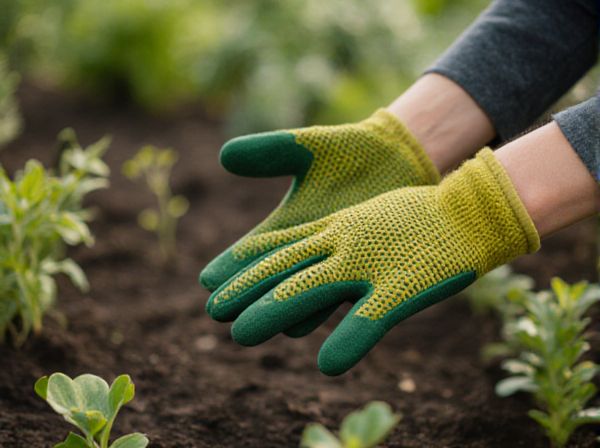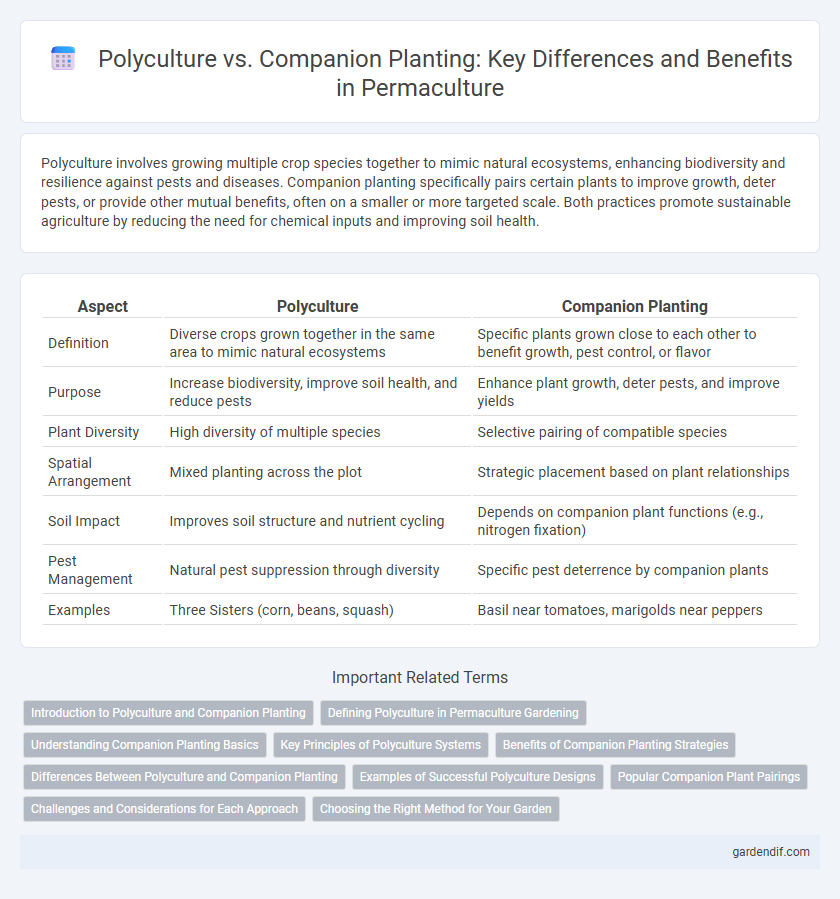
Polyculture vs Companion Planting Illustration
Polyculture involves growing multiple crop species together to mimic natural ecosystems, enhancing biodiversity and resilience against pests and diseases. Companion planting specifically pairs certain plants to improve growth, deter pests, or provide other mutual benefits, often on a smaller or more targeted scale. Both practices promote sustainable agriculture by reducing the need for chemical inputs and improving soil health.
Table of Comparison
| Aspect | Polyculture | Companion Planting |
|---|---|---|
| Definition | Diverse crops grown together in the same area to mimic natural ecosystems | Specific plants grown close to each other to benefit growth, pest control, or flavor |
| Purpose | Increase biodiversity, improve soil health, and reduce pests | Enhance plant growth, deter pests, and improve yields |
| Plant Diversity | High diversity of multiple species | Selective pairing of compatible species |
| Spatial Arrangement | Mixed planting across the plot | Strategic placement based on plant relationships |
| Soil Impact | Improves soil structure and nutrient cycling | Depends on companion plant functions (e.g., nitrogen fixation) |
| Pest Management | Natural pest suppression through diversity | Specific pest deterrence by companion plants |
| Examples | Three Sisters (corn, beans, squash) | Basil near tomatoes, marigolds near peppers |
Introduction to Polyculture and Companion Planting
Polyculture involves cultivating multiple plant species in the same space to mimic natural ecosystems, enhancing biodiversity and resilience against pests and diseases. Companion planting strategically places specific plants together to improve growth, deter pests, and optimize resource use. Both techniques support sustainable permaculture by promoting ecosystem health and increasing overall productivity.
Defining Polyculture in Permaculture Gardening
Polyculture in permaculture gardening involves cultivating multiple plant species together in the same space to mimic natural ecosystems and enhance biodiversity. This practice improves soil health, reduces pest outbreaks, and increases resilience by creating a self-sustaining environment where plants support each other's growth. Unlike companion planting, which pairs specific plants for mutual benefit, polyculture emphasizes complex, multi-species plant communities to optimize ecosystem functions.
Understanding Companion Planting Basics
Companion planting involves growing specific plants together to enhance growth, pest control, and yield, relying on mutually beneficial relationships within the polyculture framework. This method leverages natural interactions, such as nitrogen fixation by legumes or pest deterrence from aromatic herbs, to improve soil health and biodiversity. Understanding companion planting basics is essential for designing sustainable agricultural systems that mimic natural ecosystems and increase crop resilience.
Key Principles of Polyculture Systems
Polyculture systems emphasize biodiversity by integrating multiple crop species in the same space to mimic natural ecosystems, enhancing pest resistance and soil health. Key principles include spatial and temporal diversity, where plants with complementary growth habits and nutrient requirements are grown together to optimize resource use. This approach supports resilient ecosystems through ecological interactions, improving productivity and reducing the need for external inputs.
Benefits of Companion Planting Strategies
Companion planting enhances soil health by promoting nutrient cycling and natural pest control, reducing the need for synthetic inputs. Strategic plant combinations improve crop yields and biodiversity, fostering resilient ecosystems in permaculture gardens. This method supports sustainable agriculture by encouraging symbiotic relationships among plants, which optimize space and resource use effectively.
Differences Between Polyculture and Companion Planting
Polyculture involves cultivating multiple crop species simultaneously over a larger area to enhance biodiversity and ecosystem resilience, while companion planting focuses on strategically pairing specific plants in close proximity to benefit growth, pest control, or nutrient uptake. Polyculture systems replicate natural ecosystems by incorporating diverse plant types, promoting soil health and reducing pest outbreaks through complexity. Companion planting optimizes interactions between selected plants, such as nitrogen-fixing legumes alongside nitrogen-demanding crops, creating mutual benefits on a micro scale.
Examples of Successful Polyculture Designs
Successful polyculture designs include the traditional Three Sisters garden, where corn, beans, and squash grow together to enhance nutrient cycling and pest resistance. Agroforestry systems combining fruit trees, nitrogen-fixing shrubs, and shade-tolerant crops demonstrate improved soil health and biodiversity. Integrated rice-fish farming in Asia exemplifies polyculture by combining aquatic and terrestrial farming, increasing yield and ecosystem resilience.
Popular Companion Plant Pairings
Popular companion plant pairings in permaculture include tomatoes with basil, which enhances flavor and deters pests, and beans with corn, where beans fix nitrogen for corn while climbing its stalks. Marigolds planted alongside cucumbers repel nematodes, improving plant health and yield. These combinations optimize space, improve soil fertility, and reduce the need for chemical inputs in sustainable gardening systems.
Challenges and Considerations for Each Approach
Polyculture faces challenges such as managing complex plant interactions and ensuring balanced nutrient competition among diverse species, which requires careful planning and monitoring. Companion planting demands precise knowledge of beneficial plant pairings and potential allelopathic effects that can inhibit growth, making species selection critical. Both approaches require understanding local soil conditions, pest dynamics, and seasonal cycles to optimize plant health and yield.
Choosing the Right Method for Your Garden
Polyculture involves cultivating multiple complementary plant species together to create a diverse, self-sustaining ecosystem that enhances soil health and pest resistance. Companion planting focuses on strategically pairing specific plants to improve growth, deter pests, and optimize space within limited areas. Selecting the right method depends on garden size, crop variety, and desired ecological benefits, with polyculture favoring biodiversity and companion planting excelling in targeted plant interactions.
Polyculture vs Companion Planting Infographic

 gardendif.com
gardendif.com